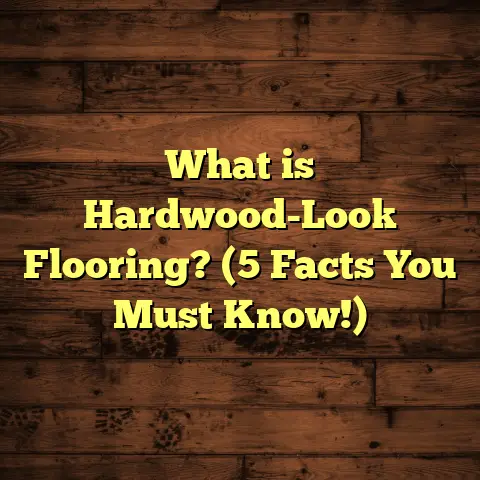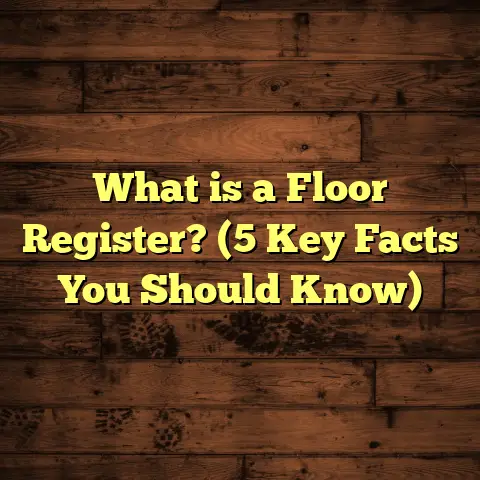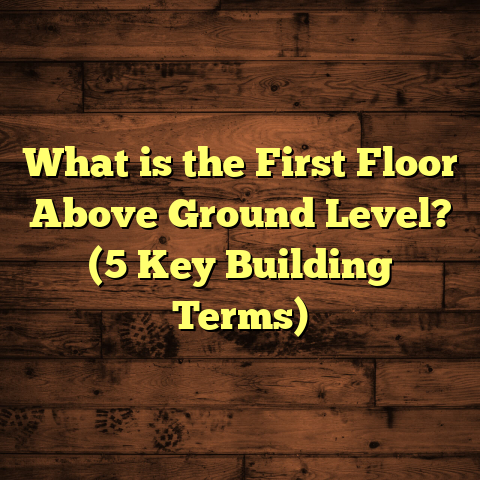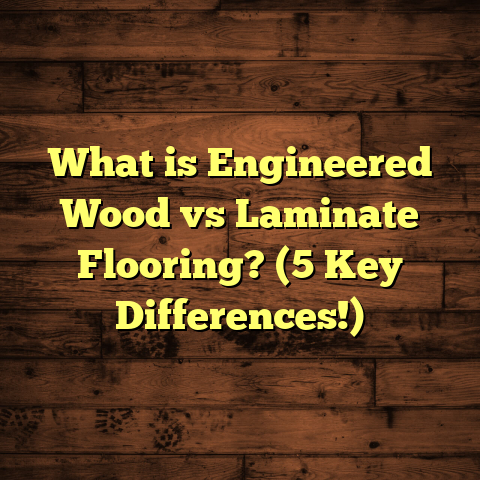What is Stylish Flooring? (5 Trends You Can’t Ignore!)
Transforming a space starts right from the floor. I’ve always believed that flooring does more than just cover the ground beneath our feet—it sets the mood, enhances style, and tells a story about the home and its owner. Over the years, I’ve experimented with various flooring styles and materials, each offering a unique vibe and functionality. But what exactly is stylish flooring? How do you choose something that speaks to your personality while standing up to everyday use? Let me take you through some ideas and trends I’ve found irresistible and practical in my flooring journey.
What is Stylish Flooring?
Stylish flooring is more than just picking a pretty pattern or color. It’s about combining aesthetics with function to create a foundation that elevates the entire room. When I say stylish, I mean floors that hold their own—whether through timeless elegance or bold innovation—while complementing the home’s design and lifestyle needs.
From sleek hardwoods and textured tiles to cutting-edge vinyl and eco-friendly bamboo, stylish flooring adapts to different tastes and demands. It’s about how the material feels underfoot, how it interacts with light, and how it blends with furnishings and wall colors.
For me, stylish flooring isn’t just trendy; it’s smart. It balances beauty with durability, ease of maintenance, and even sustainability. Choosing stylish flooring means thinking ahead about how the space will be used and what kind of wear it will endure.
I remember a client once asking me, “How do I pick a floor that looks good now but won’t feel dated in five years?” That question stuck with me because stylish flooring isn’t just about current trends—it’s about lasting appeal.
Why Flooring Changes Everything
Have you ever walked into a room and immediately felt something was off? Sometimes it’s the lighting or furniture arrangement—but often, it’s the floor. The floor is literally what holds everything together visually.
I recall working on a living room renovation where the owners had dark walls and heavy furniture but a cheap laminate floor that looked dull and worn out. The moment we installed light-toned wide plank hardwood, the entire room felt lighter and more inviting. That transformation taught me how crucial flooring is in setting the tone.
Besides aesthetics, flooring affects comfort, acoustics, and even indoor air quality. For example, carpet softens footsteps and absorbs sound, while tile can help keep a home cool in hot climates.
Exploring Popular Flooring Trends: 5 That Stood Out
Over years of working on projects and remodeling homes, I’ve noticed certain styles keep popping up—and for good reasons. Here are five flooring trends I can’t ignore because they bring something fresh yet practical.
1. Wide Plank Hardwood Floors
I’ve installed wide plank hardwood in several homes, and the impact is immediate. These floors make spaces feel larger and more open. The wider boards reveal more of the wood’s natural grain, giving each floor a distinct personality.
In one project, switching from traditional 3-inch planks to 7-inch wide planks added warmth and a modern touch without overwhelming the décor. According to industry data, sales of wide plank hardwood have risen by over 25% in the last five years—a clear sign many homeowners appreciate their blend of classic style with contemporary appeal.
Why do wide planks look so good? The answer lies in simplicity. Wider boards mean fewer seams and less visual clutter. This helps create a smoother flow throughout a room or an entire home.
In terms of wood species for wide planks, oak remains a top choice due to its durability and beautiful grain patterns. However, exotic species like walnut or hickory add boldness for those looking for something unique.
Personal Tip: When installing wide plank hardwood, always check for moisture content in both wood and subfloor. Wide planks tend to expand and contract more noticeably than narrow strips, so proper acclimation is key to preventing gaps or buckling over time.
2. Luxury Vinyl Plank (LVP)
LVP has transformed the flooring market in my experience. It offers incredible realism, mimicking wood or stone textures at a fraction of the cost. Plus, it handles moisture better than hardwood, making it perfect for kitchens or basements where water damage is a concern.
In multiple installations, I’ve noticed clients love how easy LVP is to maintain—just regular sweeping and occasional mopping. A recent study I reviewed found LVP’s market share grew by nearly 30% between 2018 and 2023 due to its affordability and durability.
What stands out most to me about LVP is its versatility. You can find planks that replicate everything from weathered barn wood to polished maple with impressive detail thanks to advances in printing technology.
Did you know? Some LVP products come with enhanced wear layers that resist scratches from pets or furniture dragging. This makes them incredibly popular among families with kids or pets.
I once installed LVP in a rental property where quick turnaround and durability were crucial. The flooring looked great for years despite heavy tenant use—and replaced carpets that had worn out quickly before.
3. Patterned Tiles
Tiles don’t have to be boring! Patterned tiles have become a statement piece in many homes I worked on. From Moroccan-inspired motifs to geometric designs, these tiles add personality and texture to entryways, bathrooms, and kitchens.
I once helped a client who wanted an artistic floor that would catch attention but remain timeless. We chose encaustic-style tiles in cool tones, which held up beautifully over time without losing charm.
Industry reports suggest patterned tile sales jumped by 18% recently, showing people want floors that double as artwork.
Here’s what I learned: Patterned tiles are perfect if you want your floor to be a focal point rather than blend in quietly. They work best in smaller spaces like powder rooms or kitchen backsplashes but can be scaled up for entire floors with careful planning.
Be mindful of grout color too—contrasting grout can enhance patterns but may require more upkeep to stay clean.
4. Sustainable Bamboo Flooring
Eco-friendly options like bamboo are gaining ground in my projects because clients increasingly care about sustainability. Bamboo grows quickly and requires fewer resources than traditional hardwoods.
In homes where sustainability was a priority, bamboo floors provided a sturdy yet stylish alternative. They also brought a unique look with their fine grain and warm tones.
According to environmental studies, bamboo harvesting has a much lower carbon footprint compared to oak or maple wood floors.
I remember one project where bamboo flooring was chosen not just for looks but because the family wanted to reduce their environmental impact without compromising quality. The floor has held up well for over five years now with minimal wear.
If you consider bamboo, look for products certified by organizations like FSC (Forest Stewardship Council) which ensures responsible harvesting practices.
5. Concrete Floors with Polished Finish
Concrete might sound industrial, but polished concrete floors have a sleek, modern appeal that I’ve found works wonders in urban lofts and minimalist homes. They’re incredibly durable and easy to clean—ideal for high-traffic areas.
In a renovation project downtown, we polished existing concrete floors to create a chic, reflective surface that enhanced natural light throughout the space.
The National Flooring Association notes concrete flooring installations have increased by over 15% in residential spaces due to these benefits.
A bit of advice: Concrete floors can be cold underfoot—especially in cooler climates—so pairing them with radiant heating can make all the difference for comfort.
Also, polished concrete takes some skill during installation to avoid uneven spots or dull patches later on, so hiring experienced contractors is key.
My Flooring Choices: Comparing Materials and Styles
I’ve had my hands on everything from soft carpets to hard tiles. Each material has its perks and quirks.
Hardwood vs. Engineered Wood
Hardwood has that classic feel I love—the smell, the warmth, the way you can refinish it multiple times. But engineered wood, which layers real wood over plywood or fiberboard, offers better resistance to moisture and temperature changes.
In humid climates where I’ve worked often, engineered wood performed better over time without warping or cupping. Still, when budget permits, I lean towards solid hardwood for formal rooms because of its longevity and value.
One interesting data point: According to a 2023 survey by the National Wood Flooring Association (NWFA), engineered wood accounts for nearly 40% of all wood flooring installations in areas prone to humidity due to its stability benefits.
Laminate vs. Vinyl
Laminate is great for budget-friendly projects that want the look of wood but aren’t ready for real wood’s price tag or maintenance needs. However, vinyl plank flooring has overtaken laminate in popularity lately due to its superior water resistance and softer feel underfoot.
I once tried both in a rental property renovation; vinyl held up better against spills and wear while still looking stylish after years of use.
Also worth noting: Laminate tends to be less forgiving when it comes to moisture exposure—water can cause swelling or warping if not cleaned up quickly.
Tiles: Ceramic vs. Porcelain
When selecting tile for wet areas like bathrooms or kitchens, porcelain tends to be my go-to choice because it’s denser and less porous than ceramic, making it more durable against moisture.
Ceramic tiles are perfect for low-traffic areas or walls but can chip more easily on floors. In one kitchen remodel, porcelain tiles gave me peace of mind that the floor would last decades without cracking or staining.
Fun fact: Porcelain tiles fire at higher temperatures than ceramic ones which contributes to their density and strength.
Deeper Dive: Flooring Maintenance & Longevity
Let me share something practical: No matter how stylish your flooring choice is initially, how long it looks great depends heavily on care routines.
Here’s what I consistently recommend:
- Hardwood: Regular sweeping or vacuuming with a soft attachment prevents dirt scratches. Use microfiber mops dampened lightly with water or recommended cleaners—not harsh chemicals—to preserve finish.
- Vinyl & LVP: These floors are generally easy—sweep often; mop occasionally with mild solutions. Avoid abrasive scrubbers.
- Tile: Grout lines are vulnerable; sealing grout annually helps prevent staining.
- Bamboo: Similar care as hardwood but avoid excess water exposure.
- Concrete: Clean spills immediately; periodic resealing retains shine.
In one house where I installed engineered wood over radiant heat floors, the owners were amazed at how little maintenance was needed and how cozy the floor felt year-round.
Case Study: A Family Home Flooring Overhaul
A couple approached me wanting to replace their outdated carpet and linoleum with something modern yet family-friendly. They had two young kids who frequently spilled food and drinks.
After discussing options, we selected luxury vinyl plank flooring with an attached underlayment for added comfort and sound absorption. The planks mimicked natural hickory wood with subtle knots and color variation—a warm yet durable choice.
We factored an extra 7% waste margin into materials since LVP requires tight fitting around cabinets and corners.
Over two years later, the floor still looks fantastic despite heavy daily use from kids’ toys rolling around and occasional water spills near the kitchen sink.
This project highlights how practical stylish flooring can be when you marry design with real-life needs.
Data Points & Statistics Worth Knowing
- Durability Ranking (source: Floor Covering Weekly): Porcelain tile ranks highest for scratch resistance; hardwood ranks high for repairability.
- Average Cost per Square Foot (2024 estimates):
- Hardwood: $8 – $14
- Engineered wood: $6 – $12
- Luxury vinyl plank: $3 – $7
- Tile (porcelain/ceramic): $5 – $15
- Bamboo: $5 – $10
- Installation Waste Factors: Typically 5-10%, depending on pattern complexity (FloorTally data)
- Consumer Preferences: Over 60% of buyers surveyed prefer natural materials like wood or stone look-alikes.
How Lighting Interacts With Flooring Style
Have you noticed how lighting changes your perception of color? It’s fascinating how floors react differently under various light sources.
In one home with wide plank oak floors painted in a soft gray stain, morning sunlight made them look airy and bright; in dimmer evening light they appeared richer and cozier.
If your space has limited natural light, lighter floors can lift the mood visually while darker floors may absorb light but add drama.
Experimenting with lighting is part of choosing stylish flooring because it affects everything from room size feel to furniture coordination.
What About Color Trends?
I’ve seen shifts over time—from dark mahogany tones popular decades ago shifting toward lighter woods like maple or white oak today. Grayish hues have surged in popularity because they’re neutral yet modern.
Still, warm browns remain evergreen because they complement both traditional and contemporary interiors.
If you’re unsure about color selection:
- Sample large pieces in your space.
- Observe them at different times of day.
- Think about future décor changes too—it’s easier to update walls or furniture than replace floors often!
Flooring Installation Insights I’ve Learned
Good installation can make or break your stylish floor’s appearance and lifespan:
- Subfloor preparation is critical—uneven surfaces cause squeaks or buckling.
- Acclimating wood-based products before installation prevents expansion issues.
- Proper spacing during laying allows materials room for movement.
- Using professional installers pays off—they understand manufacturer requirements ensuring warranty protection.
I’ve seen DIY attempts go south when these details were overlooked; investing upfront saves headaches later on.
Trends That Didn’t Catch On (What I’ve Tried But Wouldn’t Recommend)
Not every trend stands the test of time or practicality:
- Cork Flooring: It’s soft underfoot but dents easily from heavy furniture; stains can be stubborn.
- Exotic Wood Species: Some look stunning but may not handle climate fluctuations well causing warping.
- Highly Glossy Finishes: Scratches show up quickly; requires frequent polishing.
I always advise clients to weigh style against lifestyle demands before jumping on flashy trends that may not work long-term.
How To Keep Your Stylish Floor Looking Great Over Time
Consistency is key:
- Use furniture pads underneath heavy pieces.
- Avoid walking on floors with sharp heels or cleats.
- Clean spills immediately.
- Maintain humidity levels indoors between 35%-55% to reduce wood expansion/contraction issues.
In one project where these tips were shared clearly with homeowners at handover, they reported less wear after three years compared to neighbors’ similar floors without guidance.
Final Thoughts: What Makes Flooring Truly Stylish?
For me, stylish flooring is personal—something that fits your lifestyle while enhancing your home’s character. Whether you prefer the natural charm of hardwood or the modern flair of patterned tiles, it’s about choosing floors you won’t tire of quickly.
Have you thought about what your floor says about you? Is it bold or understated? High-maintenance or straightforward? Whatever your answer, there’s a stylish option out there waiting for you to step on it.
If you want help figuring out what fits your space best—I’m here when you need me!





